IRAQ: Drought Reduces 2008/09 Winter Grain Production
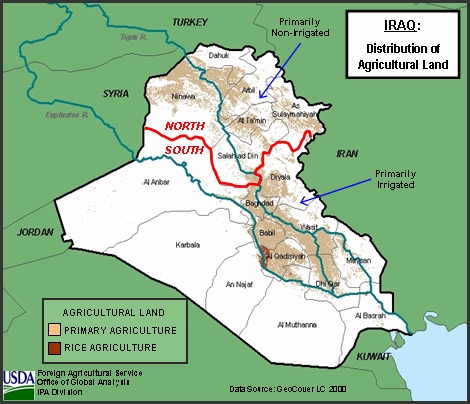 Iraq has been experiencing one of the worst droughts in the past 10 years, with total wheat and barley production in 2008/09 expected to decline 51 percent compared to last year. Drought conditions have predominated the entire winter growing season, and have severely impacted non-irrigated grain production in its northern regions. Acute dryness has also affected winter grain area and yield potential in several of the country’s primarily irrigated governorates (Iraqi provinces). Given that harvested wheat and barley crops usually account for 85 percent or more of total annual foodgrain production, a significant domestic grain supply shortage is expected, requiring sizably increased grain imports in the 2008/09 marketing year. Iraq has been experiencing one of the worst droughts in the past 10 years, with total wheat and barley production in 2008/09 expected to decline 51 percent compared to last year. Drought conditions have predominated the entire winter growing season, and have severely impacted non-irrigated grain production in its northern regions. Acute dryness has also affected winter grain area and yield potential in several of the country’s primarily irrigated governorates (Iraqi provinces). Given that harvested wheat and barley crops usually account for 85 percent or more of total annual foodgrain production, a significant domestic grain supply shortage is expected, requiring sizably increased grain imports in the 2008/09 marketing year.
Well-below normal rainfall conditions have plagued most of Iraq during the entire 2008/09 winter grain growing period. Total rainfall accumulations averaged between 28-40 percent of normal for most of the primary wheat and barley producing regions. This amounts to an average of about 4 inches of total rainfall during the 8 months between September 2007 and April 2008. During the planting period of October-December, there simply was no measurable rainfall in many regions. Moisture conditions were so poor at the start of the season in October that large swaths of rainfed grains across northern Iraq apparently went unplanted. By early December, with the winter planting window all but closed, farmers were reported by in-country sources to have delayed major planting operations in the driest regions owing to insufficient soil moisture. In addition to severe dryness, a brief period of sub-freezing temperatures during January affected most northern rainfed crop regions, adding additional stress to any established non-irrigated grains.
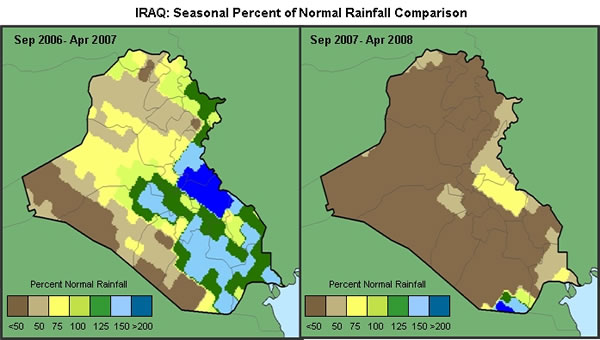
A comprehensive evaluation of winter grain establishment across Iraq was conducted on an ongoing monthly basis during the 2008/09 winter growing season, comparing the current seasonal situation to those of recent years. This analysis (illustrated in the maps below) is based on comparing satellite-based measurements of the density or vigor of growing vegetation during the past nine years. The results of the analysis clearly depicted a significant drought-related decline in grain production potential owing to a near-total lack of grain crop emergence and establishment in many major rainfed grain growing areas. The significant decline in crop vegetation in the northern primarily rainfed growing governorates of Ninawa, Arbil, Dahuk, As Sulaymaniyah, and At Ta’min is striking. These regions typically account for about 37 percent of total wheat production and 61 percent of total barley output. Ninawa on its own is particularly hard-hit, and is the country’s leading wheat and barley producing region, normally accounting for 20 percent of total wheat production and over 30 percent of Iraq’s total barley crop. In addition to these problem areas, the satellite image comparisons showed that grain area and/or crop vigor in primarily irrigated regions had also declined from the 9-year average. The most seriously affected areas were in the governorates of Diyala, Baghdad, Wasit, and Salah ad Din which typically account for 31 percent of the nation’s wheat output and 10 percent of its barley production.
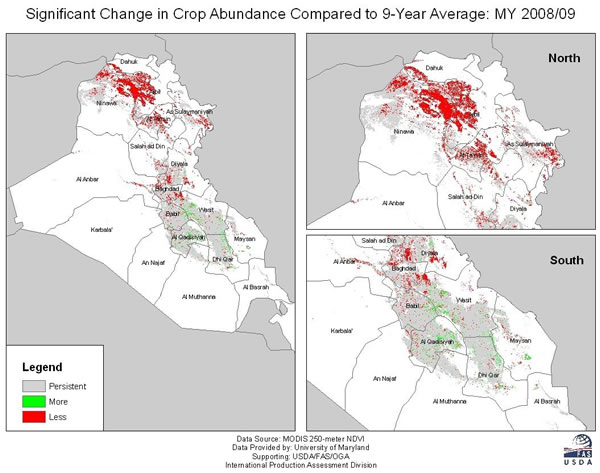
On average, farmers in Iraq cultivate about 3.25 million hectares of combined wheat and barley acreage each year. Out of this total winter grain area there is a sizable amount of irrigated acreage, totaling a little over 1.0 million hectares of wheat (46% of total wheat area) and 0.4 million hectares of barley (36 percent of total barley area). According to official Iraqi statistics (Central Organization for Statistics and Information Technology - COSIT), irrigated acreage has been gradually increasing over the past decade, providing a buffer against periodic drought. During two recent severe drought episodes in 1999/00 and 2000/01 non-irrigated wheat acreage plummeted by about 66 percent, while non-irrigated wheat production declined by 90 percent. Given the severity of current drought conditions in 2008/09, it is expected that a similarly severe decline in rainfed winter grain area and production has occurred this year. In addition to that, the satellite image analysis above also indicates that total irrigated winter grain acreage will also decline, and that crop yields on some of this land may be below average.

Typically, Iraqi farmers irrigate their fields by flooding the soil 1-3 times per season. Much of the irrigated winter grain crop receives only one irrigation application, and this occurs prior to planting to wet the seedbed and provide soil moisture for early growth. Winter rainfall acts as a supplement to this, to keep the crop progressing through its growth cycle. Yields are typically poorest on land which receives only 1 application, versus those that receive additional applications. In 2008/09 a number of adverse factors are combining to limit potential irrigated acreage in Iraq and the grain yields achieved from it. Water availability in rivers and reservoirs is reportedly down due to prolonged below normal rains in the Tigris and Euphrates watersheds. Electric power and fuel for pumps is also in short supply, while irrigation canal infrastructure has continued to deteriorate owing to lack of resources and the ongoing domestic conflict.
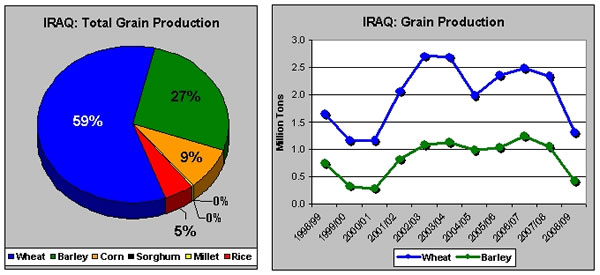
Winter grain production prospects in the 2008/09 growing season are expected to be the worst since back-to-back drought years in 1999 and 2000, when total wheat and barley production fell approximately 40 percent to only 1.5 million tons. Given their huge contribution to overall national foodgrain production, the shortfall in wheat and barley output this year is expected to be acutely felt on the domestic market. Increased grain imports will be required in the 2008/09 marketing year to offset the forecast decline in winter grain production. As illustrated in the regional grain production maps below, a very significant proportion of the country’s wheat and barley production is focused in areas severely affected by deficient moisture that are showing extremely reduced vegetation in the satellite image analysis. Owing to prolonged drought conditions wheat production in 2008/09 is forecast by USDA at 1.3 million tons, down 1.0 million or 45 percent from last year. Barley production is expected to decline even more severely this year, owing to its greater concentration in drought-affected northern governorates. Barley production in 2008/09 is forecast at 0.42 million tons or a decline of 60 percent from last year.
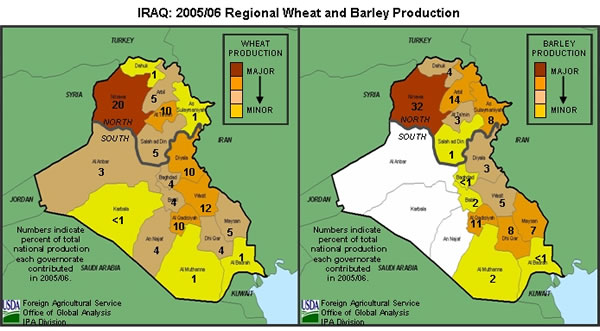
The official USDA Iraqi wheat and barley data series has been updated as of May 2008. Historical statistics from 1987-2007 have been revised to include the three northern Kurdish regions. Agricultural production information for these Kurdish governorates has not been included in official Iraq government statistics in the past. USDA personnel obtained official crop statistics from the Kurdish Ministry of Agriculture to facilitate a revision of the statistical series. To obtain these statistics, please refer to the FAS commodity website devoted to global agricultural statistics, at PSD Online.
|

